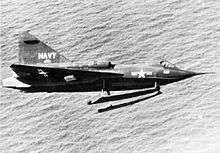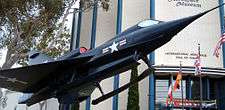Convair F2Y Sea Dart
| F2Y Sea Dart | |
|---|---|
 | |
| An F2Y Sea Dart with dual-ski configuration | |
| Role | Seaplane fighter |
| Manufacturer | Convair |
| First flight | 14 January 1953 |
| Retired | 1957 |
| Status | Retired |
| Primary user | United States Navy |
| Number built | 5 |
The Convair F2Y Sea Dart was an American seaplane fighter aircraft that rode on twin hydro-skis during takeoff and landing. It flew only as a prototype, and never entered mass production. It is the only seaplane to have exceeded the speed of sound.
It was created in the 1950s, to overcome the problems with supersonic planes taking off and landing on aircraft carriers. The program was canceled after a series of unsatisfactory results and a tragic accident on 4 November 1954, when test pilot Charles E. Richbourg was killed when the Sea Dart he was piloting disintegrated in midair. The four surviving planes were retired in 1957, but some were kept in reserve until 1962.
Development
The Sea Dart began as Convair's entry in a 1948 U.S. Navy contest for a supersonic interceptor aircraft.[1] During the time, there was much skepticism about operating supersonic aircraft from carrier decks. So in order to address this issue, U.S. Navy ordered many subsonic fighters. The worry had some foundation, since many supersonic designs of the time required long takeoff rolls, had high approach speeds, and were not very stable or easy to control—all factors that were troublesome on a carrier.[2]
Ernest Stout's team at Convair's hydrodynamic research laboratory proposed to put a Delta Dagger on water skis.[3]
Convair's proposal gained an order for two prototypes in late 1951.[4] Twelve production aircraft were ordered before a prototype had even flown. No armament was ever fitted to any Sea Dart built, but the plan was to arm the production aircraft with four 20mm Colt Mk12 cannon and a battery of folding-fin unguided rockets.[5][6] Four of this order were redesignated as service test vehicles, and an additional eight production aircraft were soon ordered as well.[7]
Design
The aircraft was to be a delta-winged fighter with a watertight hull and twin retractable hydro-skis for takeoff and landing. When stationary or moving slowly in the water, the Sea Dart floated with the trailing edge of the wings touching the water. The skis were not extended until the aircraft reached about 10 miles (16 km) per hour during its takeoff run.[7]
Required power was put up by a pair of afterburning Westinghouse XJ46-WE-02 turbojets, fed from intakes mounted high above the wings to avoid ingesting spray. When these engines were not ready for the prototypes, twin Westinghouse J34-WE-32 engines of just over half the power were installed.[8][7]
Ski configurations

The prototype was fitted with an experimental single ski, which proved more successful than the twin-ski design of the second service test aircraft. Testing with several other experimental ski configurations continued with the prototype through 1957, after which it was placed into storage.[9]
The US was not the only country to consider the hydroski. The Saunders-Roe company of the United Kingdom, which had already built an experimental flying boat jet fighter, first flying in 1947 the SR.A/1, tendered a design for a ski-equipped fighter, but little came of it.[10]
Submarine carriage
In the 1950s, the US Navy considered the internal arrangements of a submarine aircraft carrier that could carry three of these aircraft. Stored in pressure chambers that would not protrude from the hull, they would be raised by a portside elevator just aft of the sail and set to take off on their own on a smooth sea but catapulted aft in a higher sea. The program only reached the "writing on a napkin" stage, for two problems were not addressed: the hole for the elevator would have seriously weakened the hull and the load of a laden elevator would also be difficult to transmit to the hull structure.[11]
Operational history
The aircraft was built in Convair's San Diego facility at Lindbergh Field and was taken to San Diego Bay for testing in December 1952.[4] On 14 January 1953, with E. D. "Sam" Shannon at the controls, the aircraft inadvertently made its first short flight during what was supposed to be a fast taxi run; its official maiden flight was on 9 April.[12]

The underpowered engines made the fighter sluggish, and the hydro-skis were not as successful as hoped; they created violent vibration during takeoff and landing, despite the shock-absorbing oleo legs they were extended on. Work on the skis and legs improved this situation somewhat, but they were unable to resolve the sluggish performance. The Sea Dart proved incapable of supersonic speed in level flight with the J34 engines; not helping was its pre-area rule shape, which meant higher transonic drag.[12]
The second prototype was canceled, so the first service test aircraft was built and flown. This was fitted with the J46 engines, which performed below specification. However, speeds in excess of Mach 1 were attained in a shallow dive with this aircraft, making it the only supersonic seaplane to date.[13] On 4 November 1954, Sea Dart BuNo 135762 disintegrated in midair over San Diego Bay during a demonstration for naval officials and the press, killing Convair test pilot Charles E. Richbourg when he inadvertently exceeded the airframe's limitations.[14] Richbourg was a 31-year-old Navy veteran of the Second World War. He was quickly pulled from the water but did not survive the airframe breakage. He was buried in St. Augustine National Cemetery in Florida.[15]
Even before that, the Navy had been losing interest (problems with supersonic fighters on carrier decks having been overcome) and the crash relegated the Sea Dart program to experimental status. All production aircraft were cancelled, though the remaining three service test examples were completed. The two final prototypes never flew.[9]
Redesignation
Despite the fact that the airplane was officially retired and had not flown since 1957, at least one F2Y was still in storage as of 1962. As a result, it was redesignated YF-7A under the 1962 United States Tri-Service aircraft designation system.[16]
In popular culture
The pilot episode of the television series Sea Hunt features footage of the F2Y in flight and riding on the hydro-skis.[17]
Operators
Aircraft on display

All four remaining Sea Darts survive to this day.[18]
- XF2Y-1 Sea Dart, Bureau Number 137634, is in bad shape and is awaiting restoration for the Smithsonian Institution in Washington D.C..
- YF2Y-1 Sea Dart, Bureau Number 135763, is on display at the San Diego Air & Space Museum in Balboa Park. It is on loan from the National Museum of Naval Aviation at NAS Pensacola.
- YF2Y-1 Sea Dart, Bureau Number 135764, is on display at the Wings of Freedom Aviation Museum at NAS Willow Grove, Pennsylvania. It is on loan from the National Museum of Naval Aviation at NAS Pensacola.
- YF2Y-1 Sea Dart, Bureau Number 135765, is on display at the Florida Air Museum that is part of the Sun 'n Fun complex at Lakeland Linder International Airport, Florida.
Specifications (F2Y-1)
Data comes from multiple sources.[19][20][21][6]
General characteristics
- Crew: one
- Length: 52 ft 7 in (16 m)
- Wingspan: 33 ft 8 in (10.3 m)
- Height: 16 ft 2 in (4.9 m)
- Wing area: 568 ft² (53 m²)
- Empty weight: 12,625 lb (5,730 kg)
- Loaded weight: 16,500 lb (7,480 kg)
- Max. takeoff weight: 21,500 lb (9,750 kg)
- Powerplant: 2 × Westinghouse J46-WE-2 (testbed: Westinghouse J34-WE-32 w/ 3,400 lbf each) turbojets, 6,100. lbf (27 kN) each
Estimated Performance
- Maximum speed: 825 mph (1,325 km/h)
- Range: 513 mi (446 nm, 826 km)
- Service ceiling: 54,800 ft (16,700 m)
- Take-off run: 5,500 ft (1,676 m)
- Landing run: 1,500 ft (305 m))
- Rate of climb: 17,100 ft/min (86.7 m/s)
- Wing loading: 29.0 lb/ft² (142 kg/m²)
- Thrust/weight: .56 (max loaded).96 (empty)
Armament
- Guns: 4 × 20 mm (0.79 in) Colt Mk12 cannon
- Rockets: Fin-Folding Aerial Rockets
- Missiles: 2 × air-to-air missiles
See also
Related development
Aircraft of comparable role, configuration and era
Related lists
References
Citations
- ↑ Johnson 2009, pp. 230–231.
- ↑ Yenne 2009, p. 109.
- 1 2 Linder 2001, p. 148.
- ↑ Winchester 2005, p. 105.
- 1 2 Johnson 2009, p. 221.
- 1 2 3 Johnson 2009, p. 231.
- ↑ Yenne 2009, p. 110.
- 1 2 Yenne 2009, p. 112.
- ↑ 1954 Flight Archive.
- ↑ Friedman & Christley 1995.
- 1 2 Thomason 2008, p. 103.
- ↑ Convair F2Y (F-7) Sea Dart.
- ↑ Jackson 1986, p. 161.
- ↑ Charles Richbourg Grave Memorial.
- ↑ Aircraft Redesignations in 1962.
- ↑ Internet Movie Plane Database.
- ↑ Yenne 2009, p. 113.
- ↑ Jones 1975, pp. 320–321.
- ↑ Winchester 2005, p. 104.
- ↑ Taylor & Taylor 1976, p. 57.
Books
- Friedman, Norman; Christley, Jim (1995). U.S. Submarines Through 1945: An Illustrated Design History. Annapolis, MD: Naval Institute Press. ISBN 978-1-55750-263-6.
- Jackson, Robert (1986). Combat Aircraft Prototypes Since 1945. Arco/Prentice Hall Press. ISBN 0-671-61953-5.
- Johnson, E. R. (2009). American Flying Boats and Amphibious Aircraft: An Illustrated History. McFarland. ISBN 978-0-7864-5708-3.
- Jones, Lloyd S. (1975). U.S. Fighters. Fallbrook, CA: Aero Publishers. ISBN 0-8168-9200-8.
- Linder, Bruce (2001). San Diego's Navy: An Illustrated History. Annapolis, Md.: Naval Institute Press. ISBN 1-55750-531-4.
- Taylor, Michael J. H.; Taylor, John W. R. (1976). Jane's Pocket Book of Research and Experimental Aircraft. London: Macdonald and Jane's. ISBN 0-356-08405-1.
- Thomason, Tommy H. (2008). U.S. naval air superiority : development of shipborne jet fighters, 1943–1962. North Branch, MN: Specialty Press. ISBN 978-1-58007-110-9.
- Winchester, Jim (2005). The World's Worst Aircraft: From Pioneering Failures to Multimillion Dollar Disasters. London: Amber Books. ISBN 1-904687-34-2.
- Yenne, Bill (2009). Convair Deltas: From Seadart to Hustler. North Branch, MN: Specialty Press. ISBN 978-1-58007-118-5.
Websites
- "1954 Flight Archive". Flightglobal.com. Retrieved 6 April 2017.
- "Charles Richbourg (1923–1954) - Find A Grave Memorial". www.findagrave.com. Retrieved 6 April 2017.
- "Aircraft Redesignations in 1962". www.designation-systems.net. Retrieved 6 April 2017.
- "Convair F2Y (F-7) Sea Dart". www.joebaugher.com. Retrieved 6 April 2017.
- "Sea Hunt - The Internet Movie Plane Database". www.impdb.org. Retrieved 6 April 2017.
- "The US Navy's Transition to Jets". USNWC.edu. Archived from the original on 28 April 2017. Retrieved 6 April 2017.
External links
| Wikimedia Commons has media related to Convair F2Y Sea Dart. |